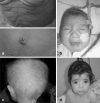Metabolic cutis laxa syndromes
- PMID: 21431621
- PMCID: PMC3137780
- DOI: 10.1007/s10545-011-9305-9
Metabolic cutis laxa syndromes
Abstract
Cutis laxa is a rare skin disorder characterized by wrinkled, redundant, inelastic and sagging skin due to defective synthesis of elastic fibers and other proteins of the extracellular matrix. Wrinkled, inelastic skin occurs in many cases as an acquired condition. Syndromic forms of cutis laxa, however, are caused by diverse genetic defects, mostly coding for structural extracellular matrix proteins. Surprisingly a number of metabolic disorders have been also found to be associated with inherited cutis laxa. Menkes disease was the first metabolic disease reported with old-looking, wrinkled skin. Cutis laxa has recently been found in patients with abnormal glycosylation. The discovery of the COG7 defect in patients with wrinkled, inelastic skin was the first genetic link with the Congenital Disorders of Glycosylation (CDG). Since then several inborn errors of metabolism with cutis laxa have been described with variable severity. These include P5CS, ATP6V0A2-CDG and PYCR1 defects. In spite of the evolving number of cutis laxa-related diseases a large part of the cases remain genetically unsolved. In metabolic cutis laxa syndromes the clinical and laboratory features might partially overlap, however there are some distinct, discriminative features. In this review on metabolic diseases causing cutis laxa we offer a practical approach for the differential diagnosis of metabolic cutis laxa syndromes.
Figures



Similar articles
-
Unique presentation of cutis laxa with Leigh-like syndrome due to ECHS1 deficiency.J Inherit Metab Dis. 2017 Sep;40(5):745-747. doi: 10.1007/s10545-017-0036-4. Epub 2017 Apr 13. J Inherit Metab Dis. 2017. PMID: 28409271
-
Clinical and biochemical features guiding the diagnostics in neurometabolic cutis laxa.Eur J Hum Genet. 2014 Jul;22(7):888-95. doi: 10.1038/ejhg.2013.154. Epub 2013 Aug 21. Eur J Hum Genet. 2014. PMID: 23963297 Free PMC article.
-
Discriminative Features in Three Autosomal Recessive Cutis Laxa Syndromes: Cutis Laxa IIA, Cutis Laxa IIB, and Geroderma Osteoplastica.Int J Mol Sci. 2017 Mar 15;18(3):635. doi: 10.3390/ijms18030635. Int J Mol Sci. 2017. PMID: 28294978 Free PMC article. Review.
-
Cutis Laxa.Adv Exp Med Biol. 2014;802:161-84. doi: 10.1007/978-94-007-7893-1_11. Adv Exp Med Biol. 2014. PMID: 24443027 Review.
-
Autosomal recessive cutis laxa syndrome revisited.Eur J Hum Genet. 2009 Sep;17(9):1099-110. doi: 10.1038/ejhg.2009.22. Epub 2009 Apr 29. Eur J Hum Genet. 2009. PMID: 19401719 Free PMC article. Review.
Cited by
-
Insights into complexity of congenital disorders of glycosylation.Biochem Med (Zagreb). 2012;22(2):156-70. doi: 10.11613/bm.2012.019. Biochem Med (Zagreb). 2012. PMID: 22838182 Free PMC article. Review.
-
Fractionated plasma N-glycan profiling of novel cohort of ATP6AP1-CDG subjects identifies phenotypic association.J Inherit Metab Dis. 2023 Mar;46(2):300-312. doi: 10.1002/jimd.12589. Epub 2023 Jan 29. J Inherit Metab Dis. 2023. PMID: 36651831 Free PMC article.
-
Unique presentation of cutis laxa with Leigh-like syndrome due to ECHS1 deficiency.J Inherit Metab Dis. 2017 Sep;40(5):745-747. doi: 10.1007/s10545-017-0036-4. Epub 2017 Apr 13. J Inherit Metab Dis. 2017. PMID: 28409271
-
New insight into clinical heterogeneity and inheritance diversity of FBLN5-related cutis laxa.Orphanet J Rare Dis. 2021 Jan 28;16(1):51. doi: 10.1186/s13023-021-01696-6. Orphanet J Rare Dis. 2021. PMID: 33509220 Free PMC article.
-
Gain-of-function mutations in the phosphatidylserine synthase 1 (PTDSS1) gene cause Lenz-Majewski syndrome.Nat Genet. 2014 Jan;46(1):70-6. doi: 10.1038/ng.2829. Epub 2013 Nov 17. Nat Genet. 2014. PMID: 24241535
References
-
- Albrecht B, De Brouwer AP, Lefeber DJ (2010) MACS syndrome: a combined collagen and elastin disorder due to abnormal golgi trafficking. Am J Med Genet A; in press - PubMed
-
- Bamatter F, Franceschetti A, Klein D, Sierro A. Gerodermie osteodysplastique hereditaire. Ann Pédiatr. 1950;174:126–127.
Publication types
MeSH terms
Substances
LinkOut - more resources
Full Text Sources
Other Literature Sources
Miscellaneous

